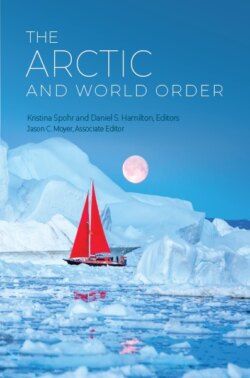Читать книгу The Arctic and World Order - Группа авторов - Страница 10
На сайте Литреса книга снята с продажи.
Power Politics and Climate Change
ОглавлениеThe media seems captivated by what reporters are hyping as a “scramble” for the Arctic, led by Russia and China. Moscow and Beijing are perceived to have joined forces, vying for geostrategic and economic advantages as the melting of the polar sea ice and the thawing of the tundra are turning the Arctic Ocean and North Siberian landmass into spaces of opportunity—with expanding fishing grounds, newly accessible untapped sources of oil, gas, and minerals and opening waterways, all believed to create increased commerce and shipping along unprecedented new optimal navigation routes. In view of this “race” for natural and material riches, some have sounded alarm over Russia’s military developments in its northern regions—the European and Far Eastern Russian Arctic terrains from Kola to Kamchatka. Others look suspiciously to China’s expansion of influence in circumpolar nations, from investments in Arctic scientific, infrastructure and hydrocarbon projects to the Beijing’s growing maritime presence in the region.38
Sino-Russian rapprochement is undoubtedly real, even if it must be noted that Russian and Chinese national interests do significantly deviate, in the Arctic and elsewhere. Moscow and Beijing have thrown down the gauntlet to Washington—as they seek to push the world’s “unipole” and “sole superpower” from its pedestal in their own pursuit of recognition as equals in a “polycentric,” “post-West world.” With talk of a “liberal order” having outlived itself and becoming “obsolete” (Putin) or with expressions of the desire to become the leading global power (Xi), Russian and Chinese leaders have not merely spelled out their ambitions. What’s more, their moves reflect a real shift in the global correlation of forces that is already under way.
At the same time, scientists have found ways to be heard in the public sphere, warning with increasing urgency of Arctic indicators for planetary climate tipping points—geophysical and climatological developments causing cascading domino effects that bring about long-term changes to current ecosystems and human activity. These climate effects are likely to be global in scope with significant consequences also for the world of politics and governance.
The first transformative change is happening on land. The second is taking place on the ice and open ocean—all because the Arctic now warms at double the rate of the global average. And the massive shrinkage of old Arctic sea ice over the past 40 summers from 8 to 4 million km2 means that there is more heat-absorbing open water and 40 percent less reflective ice. Worse, each fall in the Laptev Sea the winter sea ice forms later and each spring there is now much younger and therefore thinner and weaker Arctic ice, which in turn melts faster and puts the region’s ecosystems in danger, amplifying regional warming in the polar North.
This has several wider implications: increased and irreversible thawing of the Arctic permafrost, which releases ever larger quantities of carbon dioxide and methane into the atmosphere; and large-scale insect disturbances and an increase in wildfires, leading to a dieback of North American boreal forests and the European and Siberian taiga. Those forests now may be releasing more carbon then they absorb. Equally, the accelerating melt of the Greenland ice sheet, which is exposing the surface to ever-warmer air, could mean that at a rate of 1.5°C of global warming the sheet is doomed by 2030, bringing with it a dangerous rise in sea levels.
This is not just a regional problem. Such deeply interconnected regional transformations are believed to have planetary-scale impacts. Rising Arctic temperatures and the ensuing ice melt is driving fresh water into the seas, which could be a contributing factor to a recent 15 percent slowdown of the Atlantic Meridional Overturning Circulation (AMOC), the ocean currents driving salt and heat from the tropics and responsible for the relative warmth of the Northern Hemisphere. A further slowdown of the AMOC could destabilize the West African monsoon, triggering drought in Africa’s Sahel region. It could dry the Amazon, disrupt the East Asian monsoon and cause heat to build up in the Southern Ocean, which could then quicken the pace and scale of Antarctic ice loss, releasing more ice shelves and floes into the seas.39
While this existential threat is hard to measure, model, and grasp, scholars, policymakers and local inhabitants alike are feverishly engaged in trying to make sense of the implications and potential consequences of “Arctic change” for local livelihoods and for regional and global dynamics of power and climate. All are undertaking cost-benefit analyses—with governments weighing their national interests against the interests of all humanity.
